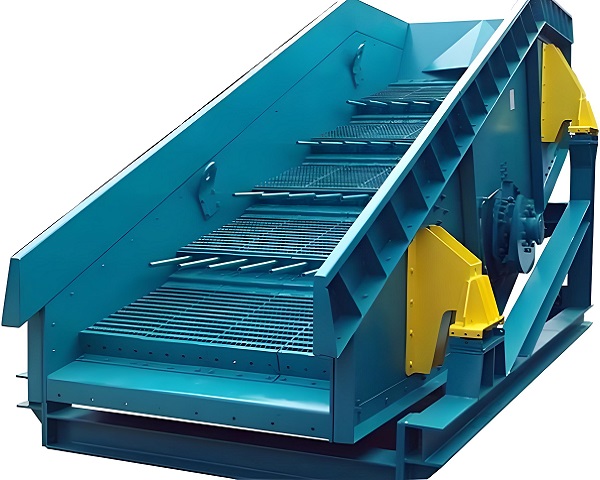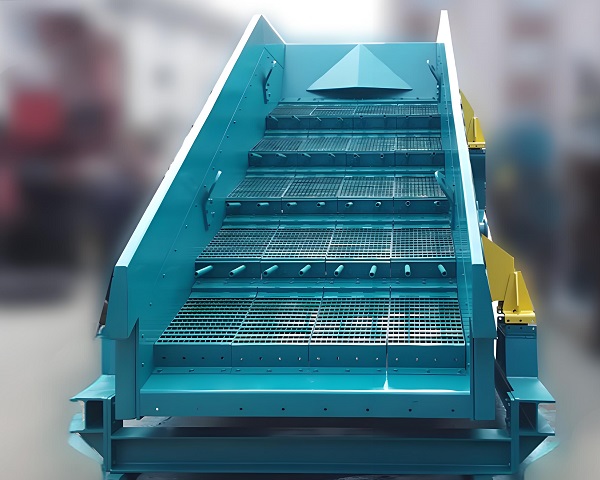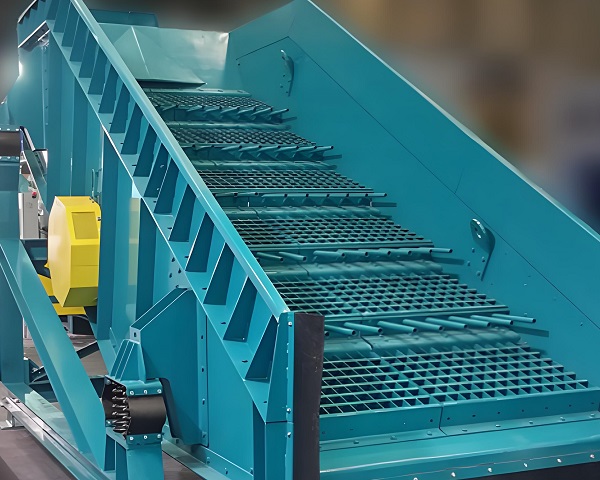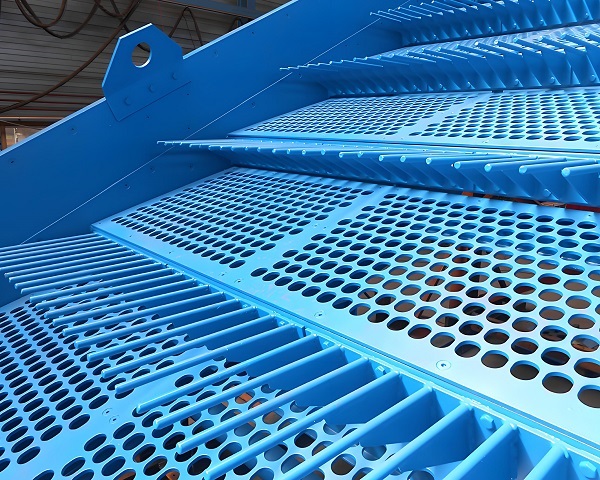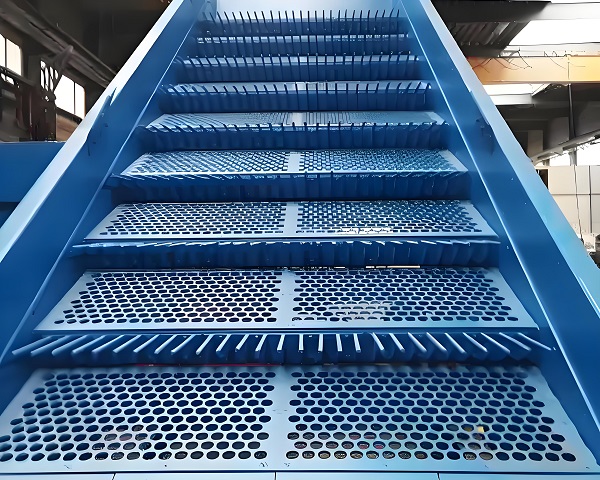A Trommel Screen is a rotary drum screening machine widely used in waste processing, mining, and construction industries. It efficiently separates materials by ......
What is the Vibrating Finger Scree
Vibrating Finger Screen is a cutting-edge technology that combines tactile feedback and touch interaction. By generating subtle vibrations on the screen surface, it brings users an immersive interactive experience beyond vision and hearing. Its core principle is based on the coordinated work of precision vibration motors and sensors: when the user touches the screen, the sensor captures the contact position and strength, and the system drives the vibration element in real time to simulate the real touch with vibrations of different frequencies and intensities, so that virtual operations can produce physical feedback.
This technology has a wide range of applications. In the field of games, Vibrating Finger Screen can significantly enhance the player's sense of substitution: in shooting games, the vibration feedback when pulling the virtual trigger enhances the real sense of operation; in racing games, the bumps on the road are transmitted through the vibration of the screen, making the player feel like he is on the track. In the daily use of mobile devices, the vibration feedback when typing makes the input more rhythmic and effectively reduces the false touch rate; when flipping through e-books, the page-turning vibration simulates the touch of paper and adds a sense of ritual to reading. In addition, in the field of medical rehabilitation, customized vibration patterns can also assist patients in finger perception training and accelerate the rehabilitation process.
Compared with traditional touch technology, Vibrating Finger Screen breaks through the limitations of flat interaction. Traditional screens rely only on visual and sound prompts, while vibration feedback gives users "touchable" digital information, which is especially suitable for the blind group - encoding text or icons through vibration to assist them in operating the device independently. However, this technology also faces challenges, such as long-term vibration may cause increased device power consumption, and the vibration parameters need to be precisely adjusted to avoid user fatigue.
With the advancement of material science and microelectromechanical system (MEMS) technology, Vibrating Finger Screen is expected to achieve more delicate touch simulation and lower energy consumption. In the metaverse and virtual reality scenes, it will become a key link between virtual and reality, creating a full sensory immersive experience for users and promoting human-computer interaction into a new era.
Operating principle of Vibrating Finger Scree
The working principle of Vibrating Finger Screen relies on precise hardware architecture and intelligent software algorithms to transform virtual touch into a real and tangible physical experience through tactile feedback. Its core operating mechanism can be analyzed from three aspects: perception, processing, and feedback.
In the perception stage, the touch sensor array built into the screen is the "eye of tactile perception". These sensors usually use capacitive or pressure sensing technology to capture the user's touch position, force, and sliding trajectory with extremely high accuracy. For example, capacitive sensors locate the touch point by detecting the change in the electric field when the finger approaches, while pressure sensors can output signals of different intensities according to the degree of pressing, providing a data basis for subsequent feedback.
Data processing is the "brain" of the entire system. When the sensor collects touch information, the signal is transmitted to the device's microcontroller (MCU) or dedicated processing chip. The chip analyzes the type of touch action, such as click, slide, long press, etc., through a preset algorithm, and calls the corresponding tactile feedback mode in combination with the application scenario. For example, in a game scenario, shooting actions and vehicle collisions require vibrations of different intensities, and the system will match the corresponding vibration parameter database according to the nature of the action.
The feedback stage depends on the precise response of the vibration actuator. At present, mainstream vibration actuators include linear resonant actuators (LRA) and eccentric rotary motors (ERM). LRA drives the mass block to vibrate along a straight line through electromagnetics. It has a fast response speed and accurate vibration frequency. It is often used to simulate short and delicate touch. ERM relies on the rotation of the eccentric rotor to generate centrifugal force to achieve vibration, which is suitable for simulating continuous, low-frequency vibration effects. When the processing chip outputs the control signal, the drive circuit adjusts the current size and direction, controls the actuator to vibrate at a specific frequency, amplitude and duration, and converts the digital signal into a perceptible physical vibration.
In addition, to ensure the authenticity and naturalness of tactile feedback, the system also needs to be fine-tuned through software algorithms. For example, an adaptive feedback mechanism is used to dynamically adjust the vibration intensity according to the device usage environment (such as silent mode, outdoor strong light); using vibration waveform synthesis technology, multiple frequency vibrations are superimposed to simulate complex touch, such as simulating the stuttering feeling when the gear turns. Through the deep collaboration of hardware and software, Vibrating Finger Screen can achieve a rich and realistic tactile interactive experience.
Advantages and features of Vibrating Finger Scree
Vibrating Finger Screen, as an innovative screening equipment, has demonstrated excellent performance in many fields. Its characteristics and advantages are remarkable, greatly improving the efficiency and quality of material processing.
Efficient screening is one of the core advantages of Vibrating Finger Screen. Through the unique vibration design, the equipment can generate high-frequency and stable vibrations, which prompts the material to be quickly and evenly dispersed on the screen surface. This efficient material dispersion method effectively avoids the phenomenon of material accumulation and clogging of the screen holes, making the screening process smooth and unobstructed, greatly improving the processing volume per unit time. In the field of recycling and garbage disposal, Vibrating Finger Screen can quickly screen a large amount of mixed garbage and accurately classify waste of different materials and sizes. Its screening efficiency is much higher than that of traditional screening equipment, laying a good foundation for subsequent resource recycling or garbage disposal.
Excellent adaptability is also a highlight of the equipment. The screen of Vibrating Finger Screen is composed of specially designed steel fingers. By adjusting the spacing and arrangement of the steel fingers and the vibration parameters of the equipment, it can easily adapt to the screening needs of various materials of different properties. Whether it is hard ore, granular sand and gravel, or irregular and entangled waste such as branches and plastic strips, it can handle it with ease. Compared with traditional fixed screen equipment, its flexibility is greatly enhanced, and it can operate stably under various complex working conditions, without frequent replacement of screens, reducing equipment maintenance costs and downtime.
In addition, Vibrating Finger Screen performs well in preventing material adhesion and clogging. The special shape and arrangement of the steel fingers, as well as the unique vibration mode generated when the equipment is running, make it difficult for the material to stay and adhere on the screen surface, and can quickly pass through the screen. Even in the face of wet and sticky materials such as wet coal and clay, it can effectively avoid clogging of the screen holes and ensure that the screening work continues to be carried out efficiently. This anti-adhesion and anti-clogging feature not only ensures the stable operation of the equipment, but also reduces the frequency of manual cleaning of the screen, and improves the degree of automation of the production process.
In terms of structural design, Vibrating Finger Screen pursues simplicity and efficiency. The overall structure of the equipment is compact, occupies little space, and is easy to install and layout. At the same time, its modular design makes key components easy to disassemble and replace, and maintenance work is simple and convenient. Once a fault occurs, maintenance personnel can quickly locate and solve the problem, greatly improving the availability of equipment and reducing the company's operating costs.
Vibrating Finger Screen has many advantages such as efficient screening, strong adaptability, anti-blocking, simple structure and easy maintenance. It plays an irreplaceable role in many fields such as industrial production and resource recycling, and provides strong support for the efficient and stable development of related industries.
Technical Parameter Table of Vibrating Finger Scree
| Model | Screen Width (mm) | Screen Length (mm) | Vibration Frequency (Hz) | Finger Material | Max Capacity (tons/hour) | Motor Power (kW) |
|---|---|---|---|---|---|---|
| VFS-500 | 500 | 1500 | 20 | Polyurethane | 10 | 1.5 |
| VFS-1000 | 1000 | 2000 | 22 | Spring Steel | 25 | 3.0 |
| VFS-1500 | 1500 | 2500 | 25 | Polyurethane + Steel | 40 | 4.0 |
| VFS-2000 | 2000 | 3000 | 27 | Spring Steel | 60 | 5.5 |
| VFS-3000 | 3000 | 4000 | 30 | High Strength Polyurethane | 100 | 7.5 |
If you have any special requirements, we will customize according to your special needs.
Product Picture Display of Vibrating Finger Scree
FAQ about Vibrating Finger Scree
>How is the screen of Vibrating Finger Screen designed to adapt to different materials?
The screen is composed of steel fingers of special shapes and materials, and the spacing between the steel fingers can be flexibly adjusted according to the particle size of the material. For materials with larger particles and harder texture, larger spacing of steel fingers is used; when processing fine or easily entangled materials, the spacing of steel fingers is reduced. At the same time, the arrangement of steel fingers can also be changed, such as staggered arrangement to prevent material bridging, and the conical design helps to separate entangled objects.
>How do vibration parameters affect the screening effect?
The vibration frequency determines the intensity of the material's beating. High frequency makes the material jump faster, which can speed up the screening speed, but too high a frequency may cause the material to pass through the screen without being fully screened; the amplitude affects the movement trajectory and beating height of the material on the screen. The appropriate amplitude allows the material to be evenly dispersed on the screen, ensuring full contact with the screen holes and improving the screening accuracy. The angle between the vibration direction and the screen will also affect the movement direction and residence time of the material on the screen, thereby affecting the screening effect.
>Can the Vibrating Finger Screen handle wet materials?
Yes. Its special steel finger design and vibration mode make it difficult for the material to stick and clog on the screen. Even when facing wet materials such as wet coal and clay, the high-frequency vibration generated by the equipment can cause the material to jump quickly, prevent it from adhering to the steel fingers, ensure that the screen holes are unobstructed, and continuously and efficiently perform screening work.
>What is the processing capacity of the Vibrating Finger Screen?
The processing capacity depends on factors such as equipment specifications, material characteristics and screening requirements. Large Vibrating Finger Screen can process hundreds or even thousands of cubic meters of materials per hour. For example, in a garbage treatment plant, it can efficiently process a large amount of mixed garbage; small equipment is suitable for scenes with smaller processing volumes, such as laboratory sample screening or material grading in a small processing plant. The specific processing volume needs to be determined according to the actual configuration and working conditions.
>How to install and debug the Vibrating Finger Screen?
During installation, first place the equipment on a stable and solid foundation to ensure that the level meets the requirements, and then connect the vibration motor, electrical control system and connectors between the components. During the debugging phase, first check whether the various components of the equipment are firmly installed, then start it without load, observe whether the equipment vibrates smoothly and whether there is any abnormal noise, gradually adjust the vibration frequency, amplitude and other parameters to achieve the best operating state, and then perform load debugging to further optimize the parameters according to the material screening effect.
>Is the maintenance of Vibrating Finger Screen complicated?
Relatively simple. The main maintenance work includes regularly checking whether the steel fingers are worn or deformed, and replacing them in time if damaged; checking the operating status of the vibration motor, adding lubricating oil and replacing wearing parts on time; cleaning the screen and the materials attached to the surface of the equipment to prevent accumulation from affecting the performance of the equipment. Due to its simple structural design, modular components are easy to disassemble and replace, which reduces the difficulty of maintenance.
>What faults may occur during the operation of Vibrating Finger Screen and what solutions can be used?
Common faults include abnormal vibration, which may be caused by motor failure, loose parts or imbalance. The motor, fastening parts and balance adjustment are required. The screen is blocked because the material is too sticky or the screen hole is too small. The vibration parameters can be adjusted, the screen can be cleaned or replaced with a suitable screen. The equipment noise is too loud, which may be caused by component wear and insufficient lubrication. The worn parts should be checked and replaced, and lubricating oil should be added.
>Can the Vibrating Finger Screen be customized to meet special needs?
Yes. Manufacturers can customize equipment size, steel finger structure, vibration system and degree of automation control according to special needs such as customer material characteristics, output requirements, site space, etc. For example, for materials with special shapes, specially arranged steel fingers are designed; for high output requirements, the equipment size and power are increased.
>Is the energy consumption of the Vibrating Finger Screen high?
The energy consumption is relatively reasonable. Through optimized design, most of the vibration energy can be naturally generated by its own structure when the equipment is running, and only a small-power drive device is required to provide the remaining energy. For example, some equipment using advanced vibration technology can maintain low energy consumption while screening efficiently, reducing the operating costs of the enterprise.
>How effective is Vibrating Finger Screen in screening recyclables of different materials in the recycling industry?
It performs well in the recycling industry. For metal recyclables, it can accurately screen out metal parts of different sizes and shapes; when processing plastic recyclables, it can classify plastics of different textures and sizes; in paper and fiber recycling, it can effectively separate impurities, ensure the purity of recyclables, and improve the recycling value.
>How long is the service life of Vibrating Finger Screen?
Under normal use and maintenance conditions, the service life is relatively long. High-quality steel and reasonable structural design make the screen and key components have good wear resistance and fatigue resistance. In general, the equipment can run stably for several years or even longer, but the specific service life is affected by factors such as material characteristics, frequency of use, and maintenance.
>What is unique about Vibrating Finger Screen compared to other types of vibrating screens?
Its uniqueness lies in the use of special steel finger screens, which are less prone to clogging and more adaptable to materials than traditional screens. The specially designed vibration mode makes the material move more reasonably on the screen and can effectively separate entangled and adhered materials. The equipment has a compact structure, occupies little space, and has a modular design that facilitates maintenance and upgrades, with obvious advantages when processing complex materials.


























